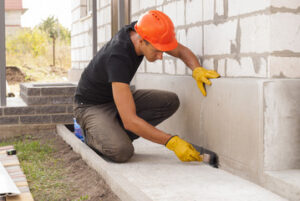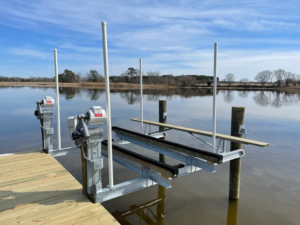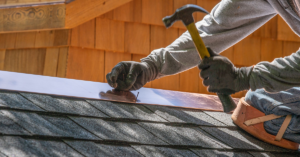If you’re thinking about buying a home with a history of foundation repair, there are some important things to consider. A structural engineer can give you a complete report and advise you about your options.

Foundation repair involves installing vertical supports under your house to lift it if it’s settled or sinking. It’s also called foundation raising and stabilization. Visit https://www.sugarlandfoundationrepair.com/ to learn more.
The cost of foundation repair varies widely because there are many different factors that influence the cost of a job. These factors include the type and severity of damage, the method used to fix it, the foundation type, the soil conditions surrounding the house, and the home size. The costs of labor and materials are also a factor.
Some foundation issues may require additional work, such as basement waterproofing or regrading the soil. In addition, the water and sewer lines must be tested to find any underground leaks. These additional tasks can add up to a considerable sum.
If you have small cracks in your foundation that don’t extend past the exterior of your home, you can usually take care of them with sealants and epoxy injection. These can be relatively inexpensive, but the cost will increase significantly if you have extensive damage or widespread moisture problems.
Other common methods for repairing damaged foundations include mudjacking and helical piers. Mudjacking is a less expensive approach that involves pumping a grout mixture beneath the concrete foundation. This lifts the foundation and stabilizes it. It’s not a permanent solution, though, and it can cause further settlement over time.
Steel piers are another popular option for stabilizing a damaged foundation. They are made from galvanized steel and have helical threaded sections that allow them to be screwed into the ground. They are effective for a wide range of foundation sizes and weights.
Using hydraulic jacks to lift the foundation is another way to correct damage. This process can be costly, but it’s a more permanent solution than other methods. Helical piers can also be installed in difficult-to-reach areas that aren’t accessible with hydraulic jacks.
In some cases, a structural report will be necessary to determine the best course of action for your home’s foundation. These can range in price from $300 to $1,000. Hiring an unbiased professional to document the damage and suggest solutions can prevent you from overpaying for repairs.
It’s important to keep in mind that even if you can’t afford to make all the required repairs at once, it’s still a good idea to contact a contractor and have them inspect your foundation regularly. This can help you spot potential issues before they become too severe, saving you money in the long run.
Time
Foundation repairs require a large amount of time to complete and the landscape around the home is often disturbed. The location of trees, bushes, and other landscaping, the amount of water on the property, construction issues, and plumbing problems can all affect how long the work takes to complete. On average, a full repair can take anywhere from two to three days.
It’s important to remember that the longer a problem is ignored, the worse it becomes and the more expensive it will be. That’s why repairing foundation cracks as soon as they occur is critical. While minor cracks in the foundation aren’t usually a sign of severe damage, they should still be repaired immediately to ensure that they don’t get worse.
The type of soil the house is built on can also affect how fast the foundation settles. Foundations built on expansive clay soil may experience more extensive damage than those that are constructed on better-draining soil. Additionally, the groundwater table below a house can shift as it rises or falls, which can cause significant upheaval of the foundation.
There are a number of factors that influence the longevity of a foundation repair, including the materials used in the construction, the amount of pressure on the foundation, and the environmental conditions. In general, the best and longest-lasting repairs are those that use concrete. In addition, a good quality contractor will provide a thorough inspection and recommend any improvements to the lot, such as root barriers, drainage plans, and proper irrigation to minimize the impact of moisture on the foundation.
Some foundation repair methods are more time-consuming than others, and it is important to consider the total cost of the project as well as your own timeline when hiring a foundation company. If the issue is complicated, it could take several weeks or even months to complete the repair, depending on the method chosen.
If you’re looking for a quick and affordable solution, Sure Safe offers a patented VR-1 foundation system that can cut repair times by up to 70%. Learn more about how our unique approach can save you money and time by clicking here.
Expertise
The foundation repair industry is booming due to an increased demand for professional services. This is because people are more aware of the importance of keeping a building’s structural integrity intact. In addition, they are becoming more proactive in identifying and addressing potential issues before they become severe. This has led to a greater emphasis on preventive maintenance, which reduces costs and minimizes risks.
The process of repairing foundations can be complex and time-consuming. It requires extensive experience and a thorough understanding of the various factors that affect foundations. These factors include soil composition, moisture content, and other environmental conditions. These factors can lead to shifting, cracking, and other damage to foundations. This is why it’s important to find a reputable contractor with extensive experience in the field.
A good contractor will begin the repair process by preparing the area. This includes getting rid of any plants that are in the way and disconnecting any underground utilities. Then, they will use the appropriate methods to stabilize the foundation and restore its functionality. This may involve digging around the foundation and using piers or pilings. They may also use epoxy crack injection to seal the cracks and other problems in the concrete.
There are many signs of foundation movement that can be misleading, but there are a few early warning signs that shouldn’t be ignored. These include uneven floors, doors and windows that don’t open or close properly, and gaps between walls and floor. These signs are a sign that the foundation is shifting or cracking and needs to be repaired.
Depending on the severity of the problem, the repair process can take hours or days. A reputable contractor will have a crew of experienced professionals who can work efficiently to complete the project in a short period of time. They will also have access to specialized equipment and tools that can speed up the repair process.
There are a number of technologies that have revolutionized the foundation repair industry. One of the most significant is ground penetrating radar (GPR). This technology allows professionals to see the condition of the soil beneath a building without damaging it. This information helps them determine the most effective solution for each individual foundation. It can also help them avoid costly repairs by identifying areas prone to heaving and shifting. Another innovative technology is hydraulics, which allow contractors to slowly and carefully lift foundations. This provides a level of control that is unmatched by traditional repair techniques.
Warranty
A foundation repair warranty is something that most homeowners look forward to having. It is a way to know that they have someone to call and work with should problems come up after the repairs are complete. The trouble is, most people don’t take the time to read or fully understand the warranties they are being offered. That is one of the biggest mistakes they can make.
Many companies will offer a lifetime warranty for their work. But, when you actually read the fine print, you may find that the warranties are very different than what is advertised. For example, you may find that some of the exclusions are so broad as to be virtually useless. These can include anything from a plumbing test, to major structural alterations, or even building a pool on your property.
Also, you will usually find that some of the warranties will only cover the foundation and not other parts of the home. You will also find that some of the exclusions will be there to protect the contractor from claims of shoddy work. For instance, a foundation repair contractor may say that their warranty does not cover piers that fail due to soil movement. They will then try to cite state laws and foundation repair associations that make this perfectly legal.
Another thing that can void a warranty is failure to maintain the area around your home. This is especially important if your foundation problems are caused by uneven moisture levels in the soil. You will have to work with a company that understands this and will help you to address drainage issues, landscaping concerns and other things that can cause future damage.
Finally, you will also need to be aware that changes in home ownership can void a warranty. You will need to contact the foundation repair company within a specified time frame, typically 30 days, if you want to transfer the policy to a new homeowner. There may be a small fee that is required to initiate the transfer. So, before you decide on a foundation repair company, make sure that you fully understand their warranty policies.







